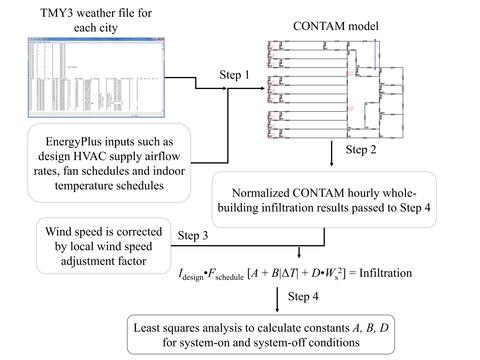NIST infiltration correlations
The Department of Energy (DOE) estimates that air leakage (or “infiltration”) through building envelopes accounted for 6 % of the total energy consumed by commercial buildings in 2010 (DOE 2014). Air barrier requirements are now included in ASHRAE Standards 90.1 and 189.1. Read more about infiltration here.
Given the energy impacts of unintended infiltration on building energy use NIST has been developing tools to better account for infiltration in building energy models. One of these tools was the development of weather-correlated infiltration inputs (or “NIST infiltration correlations”) (Ng et al., 2021). Below describes the building models used to develop the correlations, the available datasets and publications on the correlations, and a link to the video and written tutorials on how to implement them.
Commercial building models & NIST infiltration correlations
In 2011, DOE released a set of 16 commercial reference buildings (Deru et al. 2011) for EnergyPlus to assess new technologies and support the development of energy codes in pursuing building energy efficiency improvements. The models represented buildings that were constructed before 1980, constructed between 1980-2003, and constructed in 2004. In 2014, the models were updated (Goel et al. 2014) so that the modeled buildings comply with newer versions of ASHRAE Standard 90.1 Energy Standard for Buildings Except Low-Rise Residential Buildings and the International Energy Conservation Code. The table below shows the reference/prototype model by year and if the NIST infiltration correlations are available for them:
| Building type | NIST infiltration correlations available for 2004 version | NIST infiltration correlations available for 2013 version |
|---|---|---|
| Restaurant - Full Service | ✓ | |
| Restaurant - Quick Service | ||
| Healthcare - Hospital | ✓ | ✓ |
| Healthcare - Outpatient | ||
| Hotel - Small | ✓ | ✓ |
| Hotel - Large | ✓ | |
| Office - Small | ✓ | |
| Office - Medium | ✓ | ✓ |
| Office - Large | ✓ | |
| School - Primary | ✓ | ✓ |
| School - Secondary | ✓ | |
| Retail - Stand-Alone | ✓ | ✓ |
| Retail - Strip Mall | ✓ | |
| Retail - Supermarket | DOE model not released | |
| Warehouse | ||
| Apartment - Midrise | ✓ | |
| Apartment - Highrise | DOE model not released | ✓ |
Methodology
Detailed methodology on how the NIST infiltration correlations were developed can be found in the publications listed at the bottom of this page. In summary, the correlations were developed using CONTAM simulation results for the building types listed above, two different building envelope airtightness values, and eight cities following the diagram below.

The airtightness level used in these correlations were:
- 3.8 L•s-1•m-2 or 0.75 cfm•ft-2 at 75 Pa (5-sided values)
- 1.4 L•s-1•m-2 or 0.27 cfm•ft-2 at 75 Pa (6-sided values)
Datasets, publications, and tutorials
-
Download the NIST infiltration correlations: https://doi.org/10.18434/mds2-2598
-
Download the NIST infiltration correlations OpenStudio Measure: https://github.com/NREL/openstudio-model-articulation-gem/tree/develop/…
-
Related publications (2013 building models):
-
Evaluating Potential Benefits of Air Barriers in Commercial Buildings using NIST Infiltration Correlations in EnergyPlus (2021): https://doi.org/10.1016/j.buildenv.2021.107783
-
Weather correlations to calculate infiltration rates for U. S. commercial building energy models (2018): https://doi.org/10.1016/j.buildenv.2017.10.029
-
-
Related publications (2004 building models):
-
Improving infiltration modeling in commercial building energy models (2015): http://dx.doi.org/10.1016/j.enbuild.2014.11.078
-
An Improved Method of Modeling Infiltration in Commercial Building Energy Models (2014): http://dx.doi.org/10.6028/NIST.TN.1829
-

